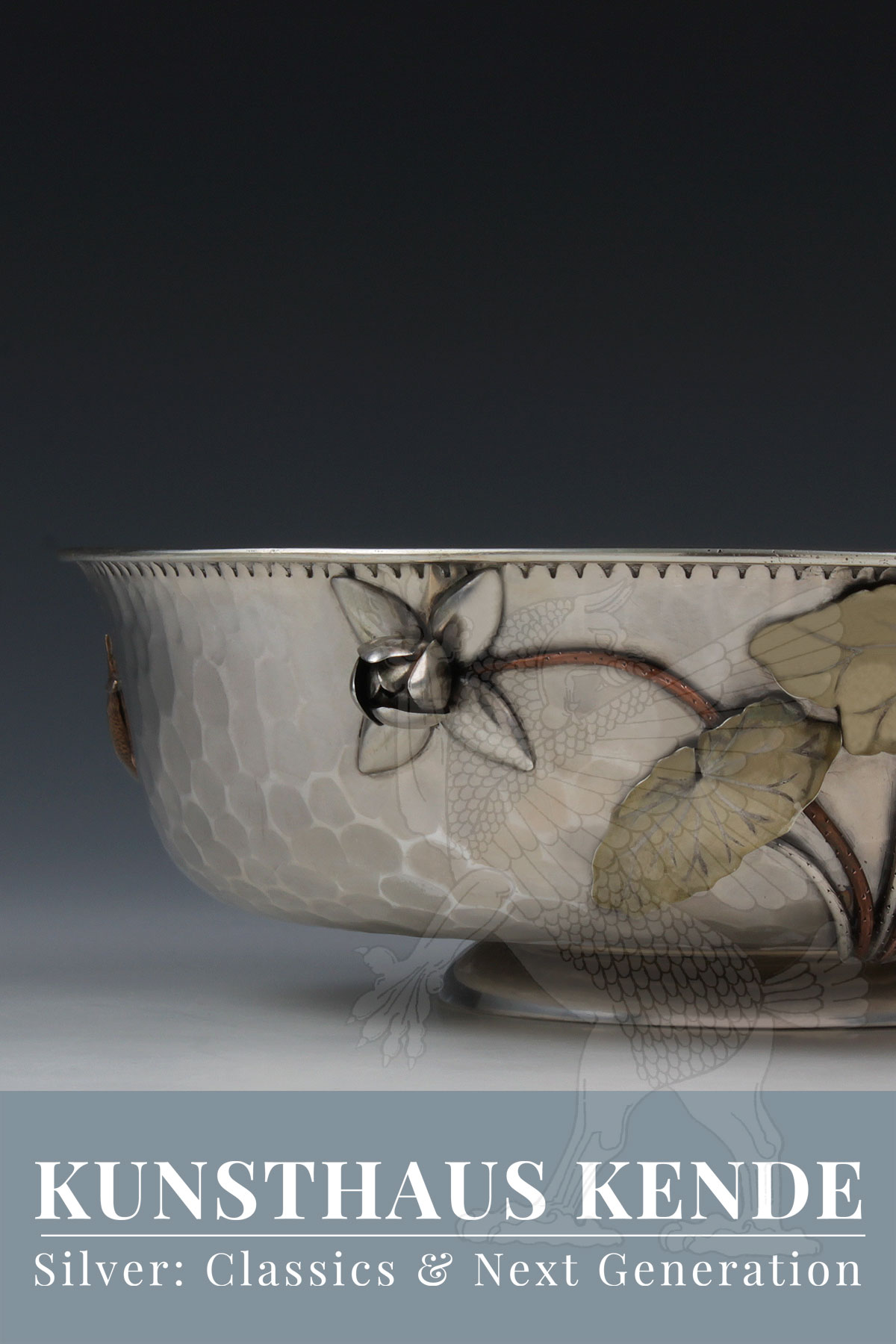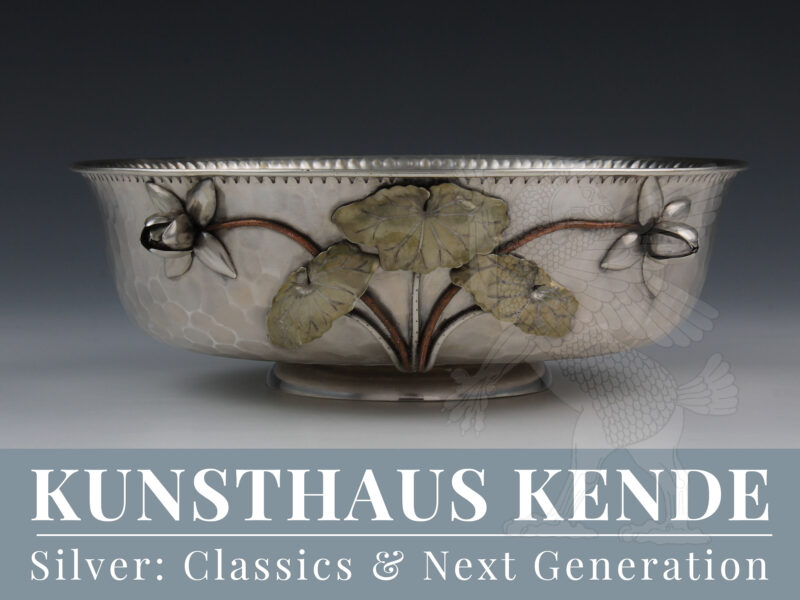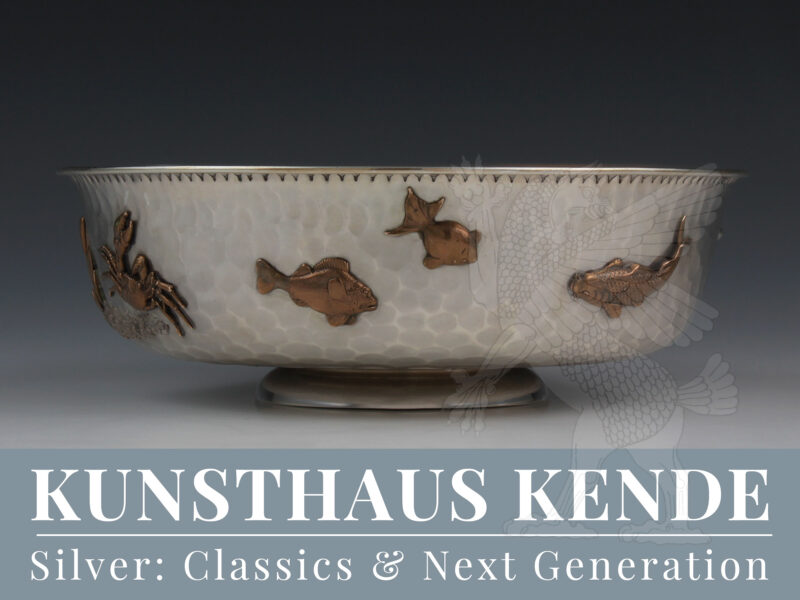Item number: 60154
A rare Aesthetic Movement sterling silver and mixed metals bowl,
Providence (Rhode Island) 1882 by Gorham Manufacturing
The round bowl standing on a central foot. The body with visible martelé, decorated by applied water lily flowers and leaves to the front as well as maritime decoration in polychrome gilt metal and bronze.
Stamped STERLING & OTHER METALS to the bottom, an the Gorham maker’s mark including year letter O for 1882 (Rainwater p. 71), and model no. 1845.
A highly elegant and rare work in the Aesthetic Style, the style parallel to the European Art Nouveau which enjoyed particular popularity in Great Britain and North America.
20.7 cm / 8.14″ diameter, 6.8 cm / 2.67″ tall; 428.0 g / 13.76 oz (gross weight)
This type of silver has its origins in Japan, which Christopher Dresser visited in 1876. During his journey he acquired numerous objects, some of which he sold to Tiffany in New York. These objects in turn inspired Edward C. Moore, the director of Tiffany’s design department, to produce silver and copper works in the Japanese style, which were presented for the first time at the Paris World Exhibition in 1878 and met with great enthusiasm. Tiffany’s success with mixed metal work quickly prompted Gorham to join this new trend, and from around 1878 Gorham produced a series of works combining silver and mixed metals in the Japanese style, of which our bowl is an excellent example.
The beginnings of Gorham Silver
If, due to its history, North America cannot look back on a tradition in the production of silverware that has grown over centuries like, for example, Great Britain, France or Germany, a number of silver factories were founded in the United States, particularly from the 19th century onwards, which produced outstandingly fine work in silver. Among the most important manufacturers of silverware, besides Tiffany, is the Gorham Manufacturing Company, which was founded in 1831 in Providence, Rhode Island, by Jabez Gorham and Henry Webster. Initially founded as a small company whose portfolio consisted of buttons, thimbles and combs, the company expanded its production to hollowware such as tea sets, candelabras, bowls and trays after Gorham’s son John took over the management in the late 1840s.
This development was a consequence of the US tariff policy, in that in 1842 the USA imposed particularly high import duties on the products of the large silversmiths, thus bringing the import of foreign silverware to a practical end.
The Rise and Fall of Gorham Manufacturing Company
John Gorham was extremely committed as a visionary managing director and turned the small company into a world-famous brand. On previous trips to Europe, John Gorham had taken the opportunity to visit the studios of European silver factories. Upon his return, he began to incorporate their silversmithing techniques into his Rhode Island workshop, expanding the premises and also having a chasing press installed. In order to incorporate the Old World style even more into Gorham’s designs, he also specifically recruited European designers such as George Wilkinson (1819-1894). Gorham’s breakthrough came with the commissioning of silver flatware and a coffee tea service for the White House by First Lady Mary Todd Lincoln in 1859. The coffee tea service later became the property of the National Museum of American History, where it still remains today. Another milestone for the company was the commissioning of a “Century Vase” by the 18th President of the United States Ulysses S. Grant in 1875. The vase weighed almost 2000 ounces (approx. 62.2 kg) and was commissioned on the occasion of the centenary of the United States.
In the period around 1880, Gorham finally succeeded in meeting the tastes of the time with outstandingly elegant designs that combined European Art Nouveau with Aesthetic Style designs and Japanese decorative elements. Gorham’s silverware, along with the work of Tiffany, is among the best American silverware of the time. The silverworks were sold in the company’s own boutiques in major cities such as New York and Los Angeles and enjoyed great popularity among the upper classes.
The company’s success continued in the 20th century with highly elegant, ornamental works of typical American Art Deco style, which were realised under Erik Magnussen. The significant decline in silver tableware in the post-World War II period led to Gorham being sold to Textron, a Providence-based industrial conglomerate, in 1967. The company merged with Lenox Holdings in 2005, which went bankrupt in 2009, ending Gorham’s 178-year history.






